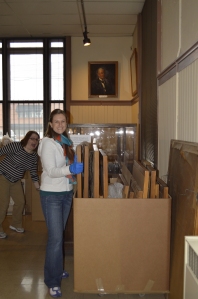Interior view of the Museum of Ceramics in East Liverpool, Ohio during the packing process.
The Museum of Ceramics, an Ohio History Connection site in East Liverpool, is about to undergo a major construction project. The museum is located in a beautiful 1909 building that once housed the Post Office. The high, vaulted ceilings and marble floors and wainscoting create an impressive atmosphere for displaying the pottery created in and around East Liverpool. However, the building does not currently have air conditioning. You can imagine the discomfort this causes visitors and staff on hot summer days; in addition, high temperatures are not ideal for preserving the objects, photographs, and archival materials in the museums care. While we are excited that the Museum of Ceramics will soon have air conditioning, construction projects large and small pose dangers to collections. Workers moving throughout the building and the use of tools and heavy equipment will cause the buildingand the exhibit cases and objects it containsto vibrate. These vibrations can dislodge objects from their mounts and cause them to fall and break. In addition, the Canadian Conservation Institute, in a study of physical agents that cause deterioration in museums, found that prolonged or continuous vibrations are also dangerous because they can cause the materials to fatigue, which can result in visible cracking on the surface of the object. Fatigue is therefore particularly concerning for pottery that can break as a result of this cracking.

Collections packed and protected from construction dust and vibration.
To protect the pottery from the potential dangers of construction, it had to be removed from display and stored in a safe place. A team of staff from the Ohio History Connection and the ICA Art Conservation who regularly work with historic objects and archival materials worked for four days in the museum. We removed countless tea cups, saucers, bowls, vases, and other pottery forms from the exhibit cases. Each piece of pottery was individually wrapped in thin newsprint for padding and packed in boxes. These boxes were then stored in areas that will be free of construction in order to protect their contents from harmful vibrations. Some pieces of pottery are particularly delicate and required a slightly different method of packing. Lotus Ware, a fine porcelain made in the 1890s by the Knowles, Taylor & Knowles Company in East Liverpool, is a very thin and delicate type of pottery. Much of the Lotus Ware at the Museum of Ceramics has ornate, applied decorations that can be easily broken off if the objects are packed too tightly or wrapped in rough paper. We wrapped these objects in layers of very thin newsprint and placed them upright in boxes surrounded by padding (i.e. crumpled pieces of newsprint) to insulate them and protect them from damage. Handles and other protruding elements were first wrapped with small, crumpled pieces of extra thin newsprint, as were thin and delicate parts of objects, such as the necks of vases. Particularly delicate pieces were also wrapped in a layer of bubble wrap before they were placed in boxes, and each box was padded with crumpled newsprint and bubble wrap for additional protection.

Curator Becky Odom and Registrar Jessica Johnson packing collections at the Museum of Ceramics prior to construction.
In addition to pottery, the Museum of Ceramics contains paintings, photographs, and archival materials that also required protection from the upcoming construction. We placed a strip of cardboard over the face of each painting and then wrapped the entire piece in ethofoam, a thin, foamy material. Larger paintings were placed in a large box separated by sheets of cardboard and strips of ethofoam. This method of storage is ideal for oil paintings that cannot be stored flat. Like the three-dimensional objects, we moved photographs, bound newspaper volumes, and other papers in the museums archives away from the areas that will be under construction. Some of these materials were small enough to be stored in boxes and moved to other parts of the museum; others we placed on tables in a secure area. Plastic sheeting will protect items stored in boxes and file cabinets near the construction areas from dust and other debris. Whether you have a large museum collection or just a few items in your home, construction projects large and small are a danger to these objects. But you can protect your collection by planning ahead and carefully storing any objects or paper materials in safe spaces away from the work.